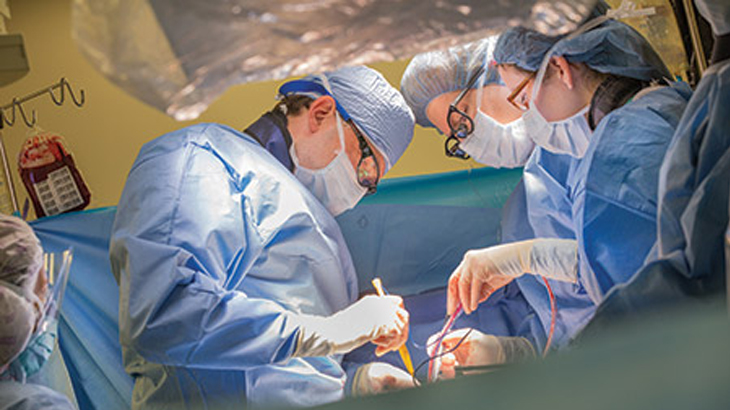Aortic root surgery is a complex procedure used to treat damage to the aorta and the aortic valve caused by an aortic root aneurysm.
The aorta is the body’s largest blood vessel, and it’s vital to your blood and oxygen supply. Aortic root surgery lets us address this condition before it can lead to an aortic dissection.
The vascular and heart surgeons at our Complex Aortic Center combine their expertise to determine the least invasive, most effective surgical options for patients with aortic root aneurysms and other conditions. We’re one of the few programs in in the Baltimore-Washington, D.C., region that can treat even the most challenging cases. Our doctors often care for patients even when they’ve been told by other providers that they can’t have surgery.
What to expect from aortic root surgery

This surgery involves removing the damaged section of your aorta and replacing it with an artificial tube known as a graft. We can replace the aortic valve or, ideally, preserve it through valve-sparing surgery.
After surgery, you’ll recover in the hospital for several days before going home. It takes about 6 weeks for the body to heal from the procedure, so you’ll need to avoid lifting heavy objects during that time.
You’ll need to control your blood pressure after aortic root surgery, as high blood pressure can increase the risk for future aneurysms. Your doctor may prescribe medication to reduce your risk of forming dangerous blood clots.
Conditions
Aortic Root Aneurysm
An aortic root aneurysm is a bulge in the wall of the point of the aorta that exits the heart, which is where the aortic valve is located.
Tests
Angiogram (Angiography)
An angiogram is a special X-ray taken as a special dye is injected through a thin, flexible tube called a catheter to detect blockages or aneurysms in blood vessels.
Cardiac Catheterization
Cardiac catheterization is a minimally invasive way to diagnose and treat a variety of heart and vascular conditions by guiding thin, flexible tubes called catheters through blood vessels to problem areas.
Computerized Tomography (CT) Scan
The cardiac computed tomography scan, or cardiac CT, uses X-rays to create three-dimensional images of your heart and blood vessels.
Echocardiogram
An echocardiogram uses high-frequency sound waves to create images of your heart.
Our providers
Location: Change location Enter your location
-
Thelma Dianne Aguilar, AGACNP-BC MSN
Cardiac Surgery & Cardiac Electrophysiology
-
Ammar S Bafi, MD
Cardiac Surgery, Valvular Disease Cardiology & Thoracic Surgery
-
Brenda Jean Beckett, ACNP MS
Cardiac Surgery, Cardiac Electrophysiology & Cardiothoracic Surgery
-
Laura Lee Cramer-Joyce, ANPBC MSN
Cardiology & Cardiac Surgery
-
Kaitlyn M. Felbaum, AGACNP-BC MS
Cardiology & Cardiac Surgery
-
Shital Gandhi, MS PAC
Heart Failure And Transplantation Cardiology, Cardiology & Structural Heart Disease Cardiology
-
Eric Solomon Ginsberg, MD
Cardiology & Hospital Medicine
-
Daniela Herring, AGACNP
Cardiac Surgery
-
Maria Gina Heyrana, ANPBC MSN
Cardiac Surgery
-
Thomas Edward MacGillivray, MD
Thoracic Surgery & Cardiac Surgery
-
Stefanie Malouf, CRSP PA
General Surgery
-
Marc Margolis, MD
Thoracic Surgery
-
Cierra Catherine O'Neill, MPAS PA
Cardiac Surgery
-
David McNeely Roberts, MSPAS PAC
Cardiology
-
Jessica Smyth, MPAS PA
Cardiac Surgery
-
John Chung-Yee Wang, MD
Valvular Disease Cardiology, Interventional Cardiology & Cardiology
Our locations
Distance from Change locationEnter your location
MedStar Health: Cardiac Surgery at MedStar Union Memorial Hospital - Calvert Street Building
3300 North Calvert Street Calvert Street Building Second Floor, Suite A Baltimore, MD 21218
410-554-6534
MedStar Health: Cardiac Surgery at MedStar Washington Hospital Center
110 Irving Street, NW First Floor Washington, DC 20010
202-877-3503
Insurance
MedStar Health accepts most major health insurance plans. If you are uncertain as to whether your individual health insurance plan is accepted at MedStar Health, please call your insurance company.









